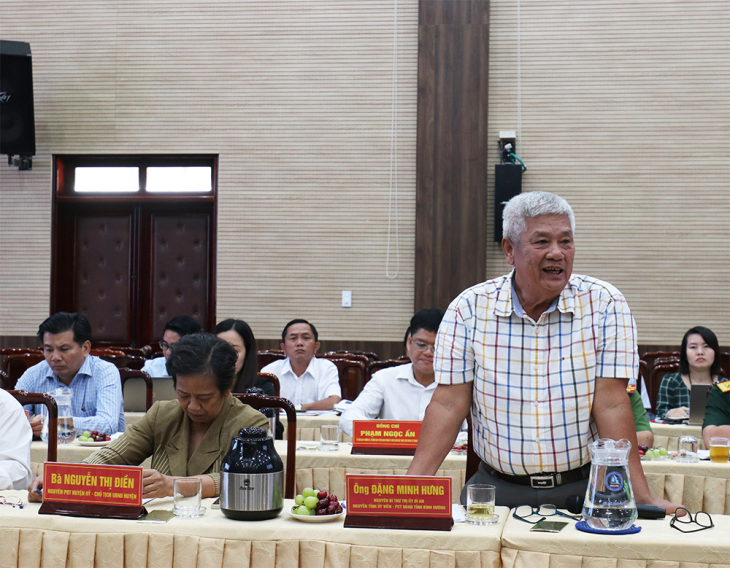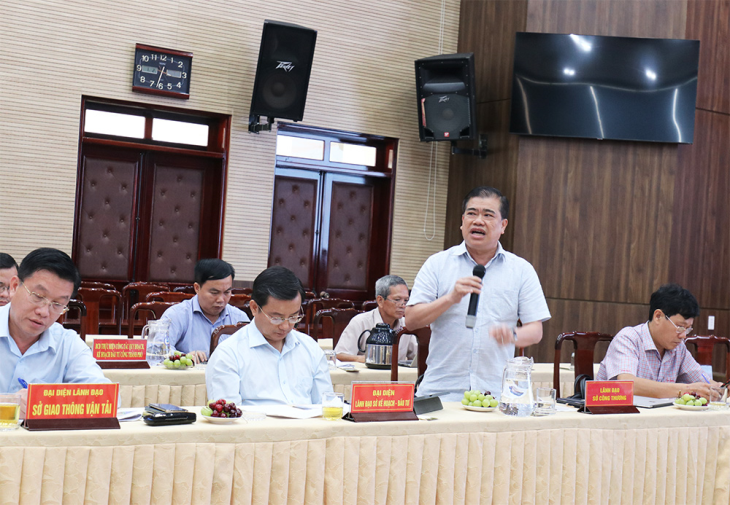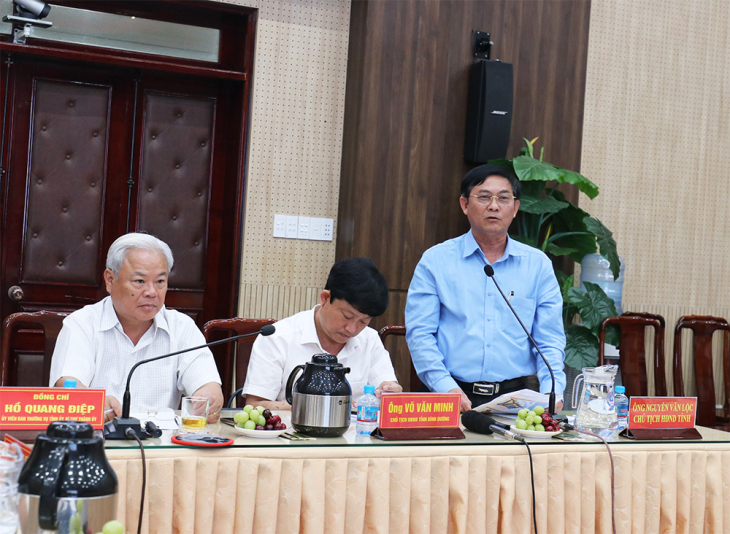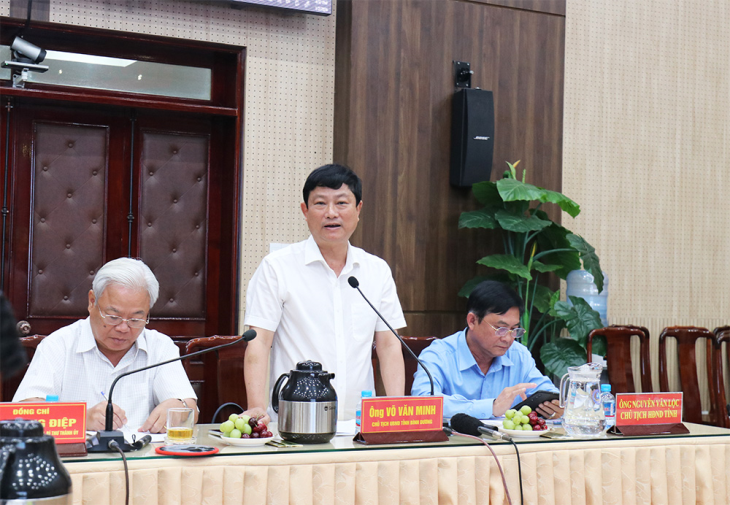The conference was attended by Mr. Vo Van Minh – Deputy Secretary of the Provincial Party Committee, Chairman of the Provincial People's Committee (PPC), Mr. Nguyen Van Loc - Member of the Provincial Standing Party Committee, Chairman of the Provincial People's Council, Mr. Vo Van Giau - Chairman of the Viet Nam Fatherland Front Committee of Ho Chi Minh City, leaders of departments and branches of Binh Duong province and Di An city.
Planning for sustainable urban development
According to the report of the consulting units, the plan to adjust Di An City's urban master planning to 2030 and orientation to 2045 (according to provincial planning orientation) will develop Di An City to a multi-polar centralized model, exploiting development driving force factors like service trade corridors and traffic hubs to form new function areas for the city. It will add linking routes to those urban functional areas around the city. At the same time, it will develop according to the TOD model, associated with functions of services at the urban, provincial, and regional levels.
The city planning will comprise of 4 surrounding commercial and service corridors, i.e., 2 cross-border commercial corridors and 2 inner-city commercial corridors.
Regarding the central structure, there will be 3 driving force areas: Di An Market Walking Street; Song Than mixed-use office-logistic area; and the Creative Center - University town.
In addition, the plan will develop a new Eastern Region III, the Di An - Loc Ninh railway.
The city's urban characteristics are a service–education–industry urban, a university urban center, and regional traffic hubs. In particular, the industry sector is oriented to developing high-tech applications. Population size ranges from 800,000 to 900,000 people with a target for civil land use of 45-60 m2/person; green land throughout the urban area is from 6m²/person, electricity used is from 2,100 kWh/person/year, and domestic water supply is from 180 liters/person/day and night.
The traffic will connect with Bien Hoa city (Dong Nai province) on 14 routes, of which 8 new routes will be opened. As in connecting with Thu Duc City (Ho Chi Minh City), there will be 27 routes with 4 new ones.
Contributing to the draft master plan, delegates said that in developing the urban, the population factor will affect every other factor of the planning. According to Mr. Dang Minh Hung - Former Vice Chairman of the PPC, the consulting units have to further clarify that the basis for determining Di An city's population size by 2045 will be 800,000 to 900,000 people. Traffic infrastructure indicators need to be reviewed suitably based on regulations. In addition, planning needs to pay attention to public land funds for education and green parks.

Mr. Dang Minh Hung - Former Vice Chairman of the PPC gives opinions on the draft master plan of Di An City
The delegates also stated that the formation of new routes is an inevitable factor in urban beautification. However, in the current context of lacking budget, Mr. Nguyen Thanh Toan – Director of the Department of Industry and Trade said that the consulting units must clearly orient the new path of each route on the basis that former-opened routes generate revenue for the budget to reinvest in the latter-opened ones. In particular, Di An needs to rely on the advantages of the international transportation station, i.e., Song Than station, located in the area to create change for the locality.

Mr. Nguyen Thanh Toan – Director of the Department of Industry and Trade gives opinions on the draft master plan of Di An City
According to Ms. Nguyen Thi Dien – Former Chairwoman of Di An City People's Committee, the increase in the population will come with the need for housing. Therefore, it is necessary to plan Di An City in a stable development way. In addition to connecting technical infrastructure with key economic regions, it is also inevitable to plan Di An in the direction of "internal" connection. In particular, Di An needs to take advantage of having Viet Nam National University, Ho Chi Minh City located in the area to develop into a Start-up - Innovation Urban. This will be a bright spot for the city in the future.
Pay attention to urban underground space planning
Participants stated that well planning will create opportunities for socio-economic development and improve the living environment as well as people's living conditions.
Mr. Vo Hoang Ngan – Director of the Department of Construction said that currently, the Prime Minister has not yet approved the province's master planning. As for localities in the province, there are currently only 02 localities that have had their planning approved by the province, including Di An City. However, Di An city can still adjust the planning after completing procedures to become a class II urban area. To develop strong urban areas, in addition to technical infrastructure such as transportation, electricity supply, water supply, drainage, and funeral homes, the city needs to focus on social infrastructures such as healthcare, education, culture, etc. The city needs to especially focus on urban reconstruction and renovation. In particular, it is necessary to pay attention to the planning of underground space in central urban areas in an overall direction, taking advantage of underground space to build urban works. This will help the city solve the problem of land funding for trees, traffic jams, etc.
Mr. Nguyen Van Loc - Chairman of the Provincial People's Council proposed that, along with comments from delegates, Di An needs to focus on building planning from the perspective of taking people as the central factor.

Mr. Nguyen Van Loc - Chairman of the Provincial People's Council gives opinions on the draft master plan of Di An City
Speaking at the conference, Mr. Vo Van Minh – Chairman of the PPC requested that Di An City must build a local master planning that closely follows the province's master planning. It is necessary to form new routes to create an urban traffic axis linked to the general urban traffic planning of the province. Especially, in the 1/2000 planning work forwards, Di An needs to boldly rebuild residential areas by forming new routes. In planning trees, it is important to ensure compliance with the prescribed ratios. In addition, the city must focus on planning land funds for social housing and planning social housing subdivisions for each area and neighborhood. Regarding institutions, priority must be given to education, health care, and culture. It is crucial to pay attention to underground space planning and review the local public land fund to solve the land fund problem. Besides, it is necessary to pay attention to the development space along main roads, urban railways, and the area around the Viet Nam National University, Ho Chi Minh City, Song Than - Suoi Tien Metro line, New Eastern Bus Station, Tan Dong Hiep quarry, East - North ring road, etc. In the economic structure, Di An needs to increase the structural ratio for service trade, which applies incentive tools for the implementation of projects to relocate factories located outside local industrial zones and clusters in local industrial zones to Northern industrial zones and clusters.

Mr. Vo Van Minh - Deputy Secretary of the Provincial Party Committee, Chairman of the PPC speaks at the conference